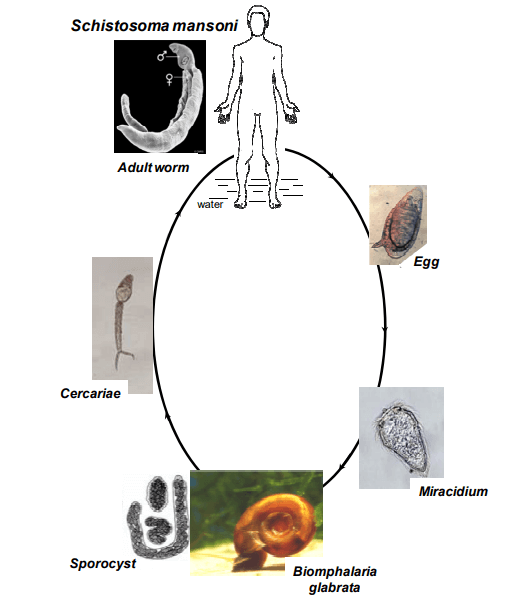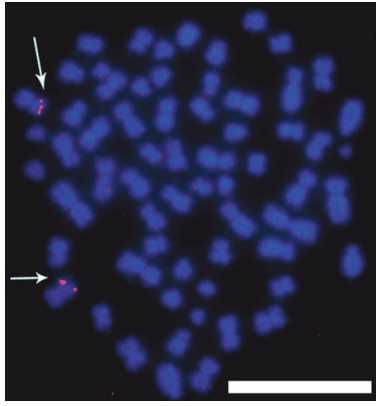Creative Bioarray provides FISH visualization analysis solutions for Biomphalaria glabrata and schistosomiasis research. Solutions designed for Beg cell lines can be adapted to a variety of commercial probes, or custom probes. Our services will assist researchers in analyzing the impact of schistosomiasis on host gene expression and developing relevant treatment strategies. The full-featured experimental platform gives us the confidence to provide customers with comprehensive analysis and testing services.
Biomphalaria Glabrata and Schistosoma Mansoni
Schistosomiasis is a harmful neglected tropical disease caused by infection with schistosomes such as Schistosoma mansoni. Schistosomiasis must transform within a mollusk host to survive. Chemical analysis of schistosome-mollusk interactions suggests that host recognition involves chemosensation, including naive host preference. Human schistosomiasis is caused by infection with a biogenic fluke of the genus Schistosoma, and the Biomphalaria snail contributes to the spread of the human schistosome, Schistosoma mansoni. The importance of this mollusk is that it has been selected as a model mollusk for whole-genome sequencing. At the same time, its importance as a model mollusk organism is that the only mollusk cell line (Bge cell line) that exists so far is derived from this snail. B. glabrata chromosomes are very small, so a good distribution of chromosomes in metaphase is crucial for identifying specific chromosomes. Numerous aneuploidies are present in B. glabrata (Bge) cell lines, and homologous chromosome pairs have been identified by genetic mapping. Recently published post-genomic studies related to the topic of snail immunity, including complementary gene linkage maps, genomic analysis of Bge cell lines, and transcriptomic and proteomic studies looking at snail-parasite interactions and innate immune memory responses to schistosomiasis. Our platform provides in situ visualization analysis solutions for Biomphalaria Glabrata and Schistosoma Mansoni.
 Fig 1. Schistosoma mansoni life cycle. (Christine Coustau, et al. 2015)
Fig 1. Schistosoma mansoni life cycle. (Christine Coustau, et al. 2015)
B. glabrata Visualization Solution
Our services are specific to Bge cells and can provide an in situ visualization solution for studies on this model organism or in cell lines. Our experimental platform has basic cell experimental capabilities and the ability to design and customize probes. The FISH protocol for Bge cell chromosomes has been optimized on our experimental platform. The main processes of the service include sample preparation (cell fixation and slide preparation), probe design and customization, FISH hybridization and imaging, and data services. Our experimental platform provides customers with short-term cell stimulation processing and culture services. Of course, our experts can also provide customers with technical guidance on cell fixation and preservation. We accept the submission of customer-defined probe solutions or select designated commercial probes to carry out analytical testing services. Our comprehensive experimental platform can adapt to most commercial reagents and probes.
 Fig 2. Representative two-dimensional FISH image of the hybridization of nonrepetitive genes onto two homologous B. glabrata chromosomes. (Edwin C Odoemelam, et al. 2010)
Fig 2. Representative two-dimensional FISH image of the hybridization of nonrepetitive genes onto two homologous B. glabrata chromosomes. (Edwin C Odoemelam, et al. 2010)
Potential Applications
Vaccine development for schistosomiasis;
To study the effect of schistosome infection on the snail epigenome;
The effect of schistosomiasis on the genome of the host animal (snail), including the expression of specific genes;
To study the molecular components involved in mediating the immune response in Biomphalaria, including the nature of the host-parasite compatibility involved and the mechanisms of parasite recognition and clearance;
The interaction between B. glabrata and its fluke parasites and the complex molecular cross-talk between the numerous antigenic, immune receptor, effector and anti-effector systems involved;
Specific interactions between B. glabrata individuals and their interacting flukes, identifying key factors that may target schistosome developmental disorders within the host, which are critical for the development of new alternative schistosomiasis control strategies;
 Fig 3. FISH services for the snail model organism Biomphalaria glabrata.
Fig 3. FISH services for the snail model organism Biomphalaria glabrata.
If you are interested in our service, please contact us for cooperation. We look forward to cooperating with you in the near future.
References
- Coustau, Christine, et al. "Advances in gastropod immunity from the study of the interaction between the snail Biomphalaria glabrata and its parasites: A review of research progress over the last decade." Fish & shellfish immunology 46.1 (2015): 5-16.
- Odoemelam, Edwin C., et al. "FISH on chromosomes derived from the snail model organism Biomphalaria glabrata." Fluorescence in situ Hybridization (FISH). Humana Press, Totowa, NJ, 2010. 379-388.


 Fig 1. Schistosoma mansoni life cycle. (Christine Coustau, et al. 2015)
Fig 1. Schistosoma mansoni life cycle. (Christine Coustau, et al. 2015) Fig 2. Representative two-dimensional FISH image of the hybridization of nonrepetitive genes onto two homologous B. glabrata chromosomes. (Edwin C Odoemelam, et al. 2010)
Fig 2. Representative two-dimensional FISH image of the hybridization of nonrepetitive genes onto two homologous B. glabrata chromosomes. (Edwin C Odoemelam, et al. 2010) Fig 3. FISH services for the snail model organism Biomphalaria glabrata.
Fig 3. FISH services for the snail model organism Biomphalaria glabrata.


